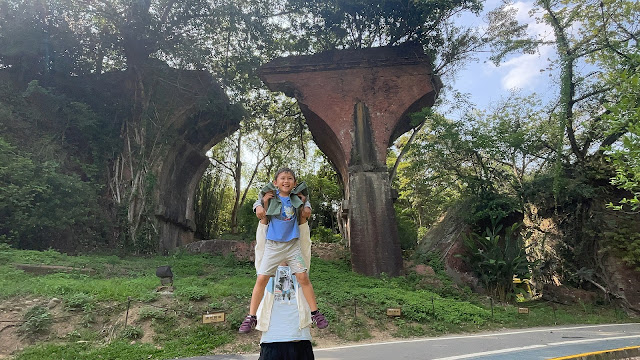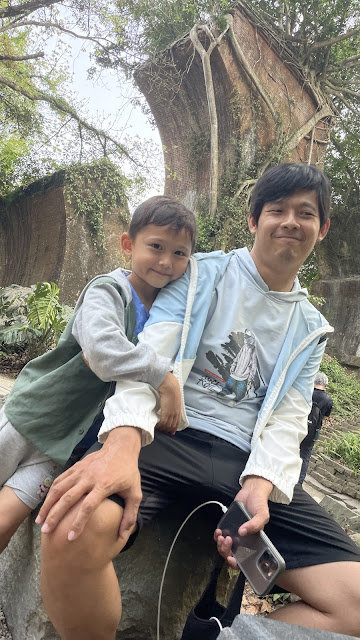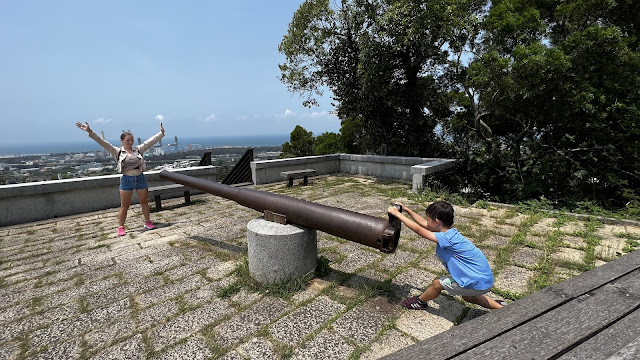Travel Date: 2024/04/20
This time, we embarked on a trip all the way south of Miaoli County. We live in the Toufen Zhunan Area, which is nearby Hsinchu. It was about a 120km scooter ride, leaving us super tired and sunburned, but it was truly enjoyable as we visited several places along the way. Our first stop was Tongxiao Shrine, a beautiful Japanese remnant. We wandered around and then walked to the memorial park above. The view from there was stunning, encompassing a vast expanse of Miaoli County, including the sea and mountains. Since it was noon, we also grabbed some food. The Sichuan-style beef noodles and luwei were particularly tasty.
Afterwards, we continued driving further south, arriving in Yuanli Township, situated on the border of Miaoli and Taichung. The old street was rather empty and not well-known, but there was one ancient house that many people visit. The house was large and exceptionally pretty; the owner kindly guided us around, explaining every little detail.
But our journey didn't end there. From the coastal area, we drove all the way to the mountainside. We passed by Hutoushan, also known as Fire Mountain in English. Though we didn't embark on a climb this time, perhaps we'll do so in the future. We then drove to Longtang Broken Bridge and explored the remains on both sides of the river. Having visited only one side in the past, it was a new experience to see both. From the bridge, we proceeded to Shengxing Station, nestled in the mountains. Though no longer in use, the area boasted several wooden houses, food stalls, and numerous tourists. From here, one can take the little train to Longteng Broken Bridge.
Initially planning to head back home, we realized it was already around the time the night market in Miaoli City opened. As we passed by, we decided to stop and visit the children's park then went on to find some foo. That marked the end of our trip. From the time we set out until we returned home, it had been a journey of around 9-10 hours.
Longteng Broken Bridge (龍騰斷橋(魚藤坪斷橋))
Longteng Broken Bridge, was originally named Yutengping Bridge. It's situated in Longteng Village, Sanyi Township, Miaoli County. Constructed in 1907, just before the inauguration of the through-line railway (later known as the Taichung Line), this bridge is a remarkable fusion of brick, steel plate beams, and truss beams. It represents a pinnacle of engineering technology in early 20th-century Taiwan, earning recognition as a symbol of the nation's industrial progress.
Designed by Hyoutaro Inagaki and overseen by American engineers Theodore Cooper and Charles Conrad Schneider, the bridge spans the Yutengping Creek, a tributary of the Jingshan Creek. Its arches and steel girders showcase a blend of traditional masonry techniques and modern steel construction. Notably, the bricks for the arches were transported from Taipei, a testament to the logistical challenges of construction in remote areas.
The Yutengping Broken Bridge endured significant damage during the Hsinchu-Taichung Earthquake of 1935, rendering it impassable. Subsequent assessments revealed extensive structural issues, prompting authorities to abandon plans for restoration. Instead, a new bridge, the Yutengping Iron Bridge, was constructed nearby in 1938, utilizing modern engineering techniques.
In recognition of its historical significance, the Yutengping Broken Bridge was designated as a cultural heritage site by the Miaoli County Government and the Executive Yuan's Cultural Construction Committee. Despite its designation, the bridge fell into disrepair over the years, exacerbated by natural disasters like earthquakes and typhoons.
Efforts to preserve the bridge gained momentum in the early 2000s, with organizations like the Yu Zhaozhong Foundation advocating for its protection. In 2001, it was named one of the "Top Ten Civil and Historical Sites in Taiwan" by various engineering and cultural institutions. Subsequently, the Miaoli County Government undertook initiatives to reinforce and repair the bridge, culminating in a significant restoration project in 2022.
The restoration project aimed to address structural issues and safeguard the bridge for future generations. However, controversies arose regarding the design of the reinforcement brackets, prompting clarification from local authorities. Despite these challenges, the restoration efforts underscored the bridge's enduring cultural and historical significance.
Today, the Yutengping Broken Bridge stands as a testament to Taiwan's industrial heritage, blending architectural ingenuity with natural beauty. As a designated historic site, it serves as a poignant reminder of the nation's past achievements and the ongoing efforts to preserve its rich cultural legacy.
Shengxing Station (舊山線鐵道自行車-勝興站)
Shengxing Railway Station, nestled in Sanyi Township, Miaoli County, holds the distinction of being the highest point along the Western Railway, boasting an altitude of 402.326 meters above sea level. This historic station, built in 1906, features a wooden structure with a distinctive Japanese-style design, believed to ward off malevolent spirits and invoke blessings.
The station played a pivotal role in the region's transportation network for over a century, witnessing the transition from steam locomotives to modern train operations. During its operational years, it served as a vital stop along the Jiushan Line of the Taiwan Railway Administration.
Over time, as railway routes were altered and modernized, Shengxing Station faced changes in its operational status. After the final southbound train departed on September 23, 1998, signaling the end of an era, the station transformed into a cherished landmark and tourist destination.
Today, visitors to Shengxing Station are greeted with nostalgic scenes. Despite the cessation of regular train services, the station remains steeped in history, preserved as a county-designated historic site since April 16, 1999.
In 2010, the Jiushan Line resumed service, albeit with limited train operations, marking a significant milestone in the station's journey. Special nostalgic train rides, such as the "CK124 Old Mountain Line Style Half-Day Tour," were introduced to celebrate the railway's legacy and promote tourism in the region.
The station's wooden building, adorned with traditional architectural elements, stands as a testament to Taiwan's railway heritage. A stone monument within the station commemorates its lofty altitude, serving as a reminder of the station's significance in the region's transportation history.
Surrounded by attractions like Shengxing Old Street, the Ancient Firewood Trail, and scenic railway routes, Shengxing Station continues to draw visitors seeking to immerse themselves in Taiwan's rich cultural and historical tapestry. As a symbol of resilience and preservation, it stands as a testament to the enduring legacy of Taiwan's railway heritage.
Before making our way back home, we made a brief stop at the children's park and the Miaoli night market. The park featured slides, climbing areas, a sandbox, and adorable Kitty sculptures. Adjacent to the park were two old tanks, adding a unique touch to the surroundings.
I highly recommend trying the BBQ at the park entrance, especially if you enjoy the flavors of Tainan. Additionally, at the opposite corner's entrance, there's BBQ corn available, which is equally delicious.
Despite the enjoyable time, I ended up with quite a sunburn, as the sun remained on the same side of my body throughout the journey back and forth. My legs were particularly red that day - an unintended souvenir of our adventure haha
Address:
1. South Site of the Broken Bridge: 367苗栗縣三義鄉龍騰斷橋
2. North Site of the Broken Bridge: 367苗栗縣三義鄉苗49鄉道
3. Shengxing Station: 367苗栗縣三義鄉83號
4. Children's Park: 360苗栗縣苗栗市玉清路351號
5. Night Market: 360苗栗縣苗栗市英才路







































































